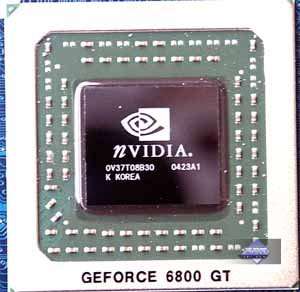ASUS V9999GT 128MB DDR
Based on NVIDIA GeForce 6800GT
|
Contents
- Introduction
- Video card's features
- Testbed configurations, benchmarks
- Test results: summary performance diagrams
- Conclusions
We proceed with our analysis of new series 6800/6800GT/6800Ultra video cards. I suppose, there is no point in describing these processors after their announcement six months ago, we have mentioned them a lot in our articles.
Theoretical materials and reviews of video cards, which concern functional properties of the GPU ATI RADEON X800 (R420)/X700 (RV410) and NVIDIA GeForce 6800 (NV40)/6600 (NV43)
I'll remind you that GeForce 6800GT is a sterling 16-pipeline chip (I mean pixel pipelines), which differs from 6800 Ultra only in frequencies (350 MHz versus 400-425 MHz in "Ultra"). According to the reference specs this processor must be equipped with 256 MB of GDDR3 RAM with 2.0ns memory access time operating at 500 (1000) MHz.
However ASUSTeK is famous for its love of hybrid designs. We have already seen one by the example of V9999 GE, when GeForce 6800 was installed on a PCB from 6800 Ultra operating at frequencies of 6800GT (350/1000 MHz). In this case everything is vice versa: GeForce 6800GT is installed on a PCB from 6800, equipped with 128 MB of memory operating at 350 (700) MHz. That's the V9999GT video card.
Video card
|
ASUS V9999GT 128MB DDR
|
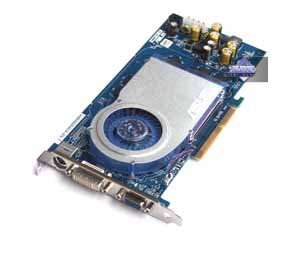
|
|
ASUS V9999GT 128MB DDR
|
|
The card has the AGP x8/x4 interface, 128 MB DDR SDRAM allocated in 8 chips on the front side of the PCB.
Hynix memory chips. 2.8ns memory access time, which corresponds to 350 (700) MHz, at which the memory operates. GPU frequency — 350 MHz. 256bit memory bus. Pixel pipelines x texture units - 16x1. 6 vertex pipelines.
|

|
|
Comparison with the reference design, front view
|
|
ASUS V9999GT 128MB DDR
|
Reference card NVIDIA GeForce 6800
|

|
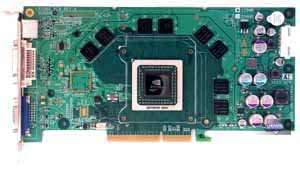
|
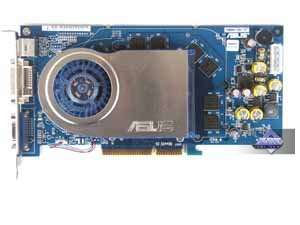
|
|
Comparison with the reference design, back view
|
|
ASUS V9999GT 128MB DDR
|
Reference card NVIDIA GeForce 6800
|

|
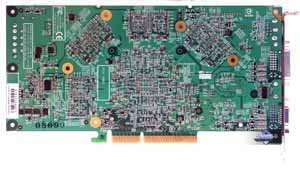
|
The card is obviously almost an exact copy of the reference design for GeForce 6800. The cooling system is very narrow, that's why the card does not block the second to AGP slot.
Let's have a closer look at the cooler.
|
ASUS V9999GT 128MB DDR
|
|
On the whole the cooler is very much like the reference one, it also consists of a central heatsink installed on the core, only without a bent heatsink to cool the memory chips. The heatsink is covered by a cap with a fan, which forms closed space to blow the air through.
The salt of the cooler is in its illumination, that's why the cap of the cooler is partially made of semitransparent plastic.
|

|

|
Our hero of the day (GeForce 6800GT processor) is expectedly located under the cooler.
Bundle.
|
ASUS V9999GT 128MB DDR
|
|
The box contains a user's manual, a CD with drivers, the entire brand box with game CDs (the bundle list can be clearly seen on the screenshot to the right), TV extension cords, DVI-to-d-Sub and SVideo-to-RCA adapters. Unfortunately the bundle lacks an external power cable.
|
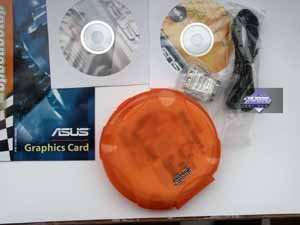
|

|
Have a look at the box.
|
ASUS V9999GT 128MB DDR
|
|
The box is made of millboard with traditional ASUS design
|

|
Installation and Drivers
Testbed configurations:
Pentium4 Overclocked 3200 MHz (Prescott) based computer
- Intel Pentium4 3600 MHz CPU (225MHz x 16; L2=1024K, LGA775); Hyper-Threading enabled
- ABIT AA8 DuraMAX mainboard based on i925X
- 1 GB DDR2 SDRAM 300MHz
- WD Caviar SE WD1600JD 160GB SATA HDD
- Athlon 64 3200+ based computer
- AMD Athlon 64 3200+ (L2=1024K) CPU
- ASUS K8V SE Deluxe mainboard based on VIA K8T800
- 1 GB DDR SDRAM PC3200
- Seagate Barracuda 7200.7 80GB SATA HDD
- Operating system – Windows XP SP2; DirectX 9.0c
- Monitors: ViewSonic P810 (21") and Mitsubishi Diamond Pro 2070sb (21").
- ATI drivers v6.476 (CATALYST 4.9); NVIDIA drivers v65.76.
VSync is disabled.
Test results: performance comparison
We used the following test applications:
- Unreal 2: The Awakening (Infogrames), DirectX 8.1, multitexturing, tests are performed using the Bench'emAll! 2.59.
- RightMark 3D (one of the game scenes) – DirectX 8.1, Dot3, cube texturing, shadow buffers, vertex and pixel shaders (1.4). Test settings: pixel shaders 1.1, shadow buffers OFF.
- Half-Life2 (Valve/Sierra) – DirectX 9.0, demo ixbt01. Tests were carried out with maximum quality.
- Call of Duty (MultiPlayer) (Infinity Ward/Activision) – OpenGL, multitexturing, ixbt0104demo, test settings – maximum, S3TC ON
- Tomb Raider: Angel of Darkness v.49 (Core Design/Eldos Software) — DirectX 9.0, Paris5_4 demo, test settings are provided here.
- Far Cry v.1.3 (Crytek/UbiSoft), DirectX 9.0, multitexturing, demo01 (the game is started with the option -DEVMODE), test settings – Very High.
- DOOM III (id Software/Activision), OpenGL, multitexturing, ixbt1-demo (33MB) test settings – High Quality. Configuration files were created with caching in order to optimize the game and to reduce the jerks. You can download them as well as a batch file to launch the benchmark here (35K)
- PainKiller v.1.31(People Can Fly/Dreamcatcher) – DirectX 9.0, multitexturing, maximum possible test settings. Integrated benchmark was used.
- 3DMark05 (FutureMark) – DirectX 9.0, multitexturing, test settings – trilinear.
If you want to get the demo-benchmarks, which we use, contact me at my e-mail.
Performance
- 1. Call of Duty
- 2. FarCry
- 3. Unreal 2: The Awakening
- 4. Tomb Raider: The Angel of Darkness
- 5. RightMark 3D
- 6. Half Life 2
- 7. DOOM III
- 8. Painkiller
- 9. 3DMark05 Game1
- 10. 3DMark05 Game2
- 11. 3DMark05 Game3
- 12. 3DMark05 MARKS
Conclusions
As we can see, despite the initial scepticism about how bad it is to limit this powerful chip by a low memory bandwidth and twice as low memory capacity, the test results demonstrated that this video card is one of the most attractive ones! Its price being only a little higher than for regular GeForce 6800, it has a powerful chip! It plays its role. The accelerator works off its price just fine.
Will it be for long? When will the games come out, which will require more than 128 MB memory? - It's a difficult question, many people ask it. That's what I think: if you want to get a fast and reliable video card for the nearest year – V9999GT is your choice. If you want an accelerator for 1.5-2 years in advance, you'd better buy a "sterling" GeForce 6800GT.
ASUS V9999GT 128MB DDR proved itself good in all aspects! Both the operating stability (I mean our sample, of course) and the quality in 2D in 1600x1200 at 85Hz are excellent.
In our 3Digest you can find more detailed comparisons of various video cards.
Write a comment below. No registration needed!
|
|
 |
|
|
|

